First Drive: 6th Generation BMW 7 Series (Prototype) by Henny Hemmes
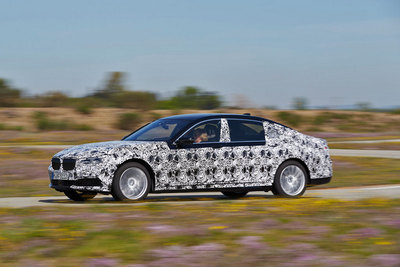 |
SEE ALSO: Official June 2016 BMW 7 Series Unveiling
SEE ALSO: 2016 BMW 7 Series Specs, Pricing and Options
During the past days BMW organized some work shops for a small group of media at their Miramas test track in the south of France. It was meant to familiarize us with the innovations that will soon appear in the new 7 Series.
Even though the Bavarians do not want to confirm a date of the premiere of their flagship, we are pretty sure that the fourth generation ‘7 ‘ will bow at the Frankfurt Auto Show in September. It is more or less confirmed by the fact that, that BMW is presenting the new 7 Series to a select group of customers in Miami, Fl; which I learned today.
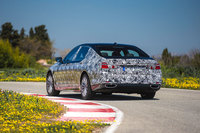 |
The Real Thing
We drove the new model on the former Circuit de Provence
- BMW’s base for research and development - and it felt right. Of
course, it was still wearing the familiar black and white camouflage
stickers, and the dashboard and door panels were covered. But the short
drive at a sporty speed, felt like the real thing.
In three different work shops, the BMW engineers showed us the ins and outs of the technology that has been developed and used for the 7 Series. Not only the technical innovations, but also those with respect to connectivity and driver assistance systems that we will see in the 7 Series.
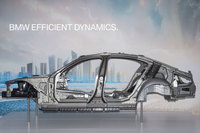 |
Classified The body, in-white, simply said the framework is made of a combination of steel, aluminum and CFRP (carbon fiber reinforced plastic, or 'carbon'). Together with other weight saving measures, the new 7 Series is 440 pounds lighter than the outgoing model, but due to the use of new safety systems, the net loss is 286 pounds. Important is that much of the weight is saved on parts that are above the center of gravity of the car. For instance the roof beam assembly is made of CFRP, as well as the tunnel and rear quarter panels.
BMW applies so-called core free production to form the hollow CFRP tubes and also uses a density for the carbon material’s weave that differs depending on the load. The process is so secret that only a few specialized employees are allowed in the production unit in BMW’s plant in Landhut, Germany.
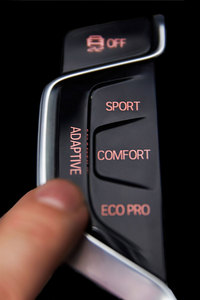 |
Using aluminum for the transversal arm saves around 0.8 pounds and the lighter design of the bearing hubs sheds another 0.9 lbs. The disc of the brake discs are made of steel, the hubs are in aluminum. Critical is the linkage, that has to be done with a special technique and is only suitable for larger disc brakes, starting with 17-inch.
The 7 Series will be available with different engines, including a new 6-cylinder variant of the new family of power plants, which is less heavy than the outgoing unit and is combined with an evolution of the 8-speed Steptronic transmission. This can process data from the navigation system in order to preview the route and optimize fuel consumption.
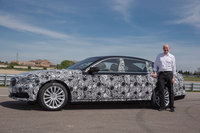 |
Lowering Automatically A key element is the innovative technology that is used for the chassis. The new 7 Series is standard equipped with air suspension up front (it had already air in the rear) and with active damping.
The 7 Series has three drive modes: Eco Pro, Comfort and Sport as well as a combination dubbed Adaptive. In Sport the car is lowered automatically by 10 mm (0.4inches) There is no Sport + mode anymore, because DSC can be switched off in the drive select mode Sport.
In Adaptive mode, Comfort and Sport set up are used automatically depending on the input received by the sensors. If the driver is actively steering and pushing the throttle, it will be Sport, if the drive is relaxed then the mode changes to Comfort. It is a real comfort feature because you do not have to switch anymore when you get stuck behind a truck or when you want to get out of heavy traffic quickly.
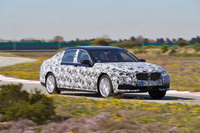 |
Chassis Guru
Obviously, Jos van As had an important share in the
development of the new technology and the testing and adjusting to each of
the underlying systems. My Dutch compatriot is regarded as the chassis guru
of the company, but his official title is ‘'vice president functional
integration and functional design driving dynamics’. He is
responsible for the development and adjustment of the suspension of all
models of the BMW Group.
During several laps – my ‘work’shop number one – I could experience how smooth the transition is from one mode to the other. And how agile the handling of the large car is. When I later realized that I was driving the Long-wheel-base version, I was even amazed. We drove the LWB because customers in two of the three main markets for the 7 Series, North America and China, mostly buy the long version. Europe and other markets get the SWB, which offer an even more sporty feeling, according to Jos van As. When I say that he did a real good job, he laughs away the compliment: “It is the whole team, you know that.” Sure, I realize that, especially when I see the curious faces of the engineers present at the test track, and their happy smiles when they see that we like the drive. But it is the gut feeling and decades long experience of Jos van As that puts the dots on the 'i' in the final stages of setting up the cars.
 |
Prepared for the Autonomous Future
The new 7 Series also gets added and
new features for the ConnectedDrive system. New is remote control parking.
Driver and passengers can leave the car comfortably opening the doors and,
upon a push on the button of the key fob, the car autonomously parks itself
in tight spaces or the garage. The maximum distance that the car can cover
driverless in and out of parking spaces is 1.5 times the length of the
car.
That BMW has technology that enables cars to drive autonomously is already known. Remember, last year I rode shotgun in a self-driving race car at the Las Vegas Speedway. In the new '7' some of this technology is available in the form of ACC, automatic cruise control with speed limit assist. In this case the limit is noticed by a camera in the car and the speed is automatically adapted until the next sign with a different speed.
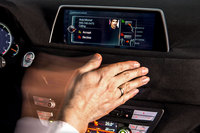 |
Another technology that is part of a future autonomous driving system, is Driving Assistant Plus that includes steering and directional control assistant, lane departure warning and the likes.
On the track we could also feel how an enhancement of lane departure warning works. I drove on the left lane of the three lane part of the test track and kept my hands off the steering wheel. The car followed the bend, but started a warning in the IP by showing a small steering wheel with hands, to tell me hands-on. It will turn red, in case it takes me too long to put my hands back and there is an acoustic signal as well. The systems use a stereo camera and radar sensor at the front and sides of the car to detect road boundaries, vehicles travelling ahead and those approaching from the side and rear. At speeds up to 130 mph they help drivers to stay in the center of the lanes or avoid unintentional lane departures.
Gesture Control
Last but not least, the new Seven will get the latest
state of smart operation of the ConnectedDrive system. First of all by
means of the familiar iDrive controller in the center console, by touch
control, voice control and by the completely new gesture control. In the
roof, just in front of the adjustment of the rear view mirror is a c3d
sensor that ‘sees’ hand movements near the center console.
Gestures can be used for instance to adjust the volume of the audio system,
or to accept an incoming phone call. Then the driver – or the
passenger – can point a finger to the display which means that the
call is accepted. In order to reject a call, a wave of the hand is enough.
Gesture control is an alternative to using the iDrive controller, without
having to activate it separately. A symbol in the Control Display indicates
whether gesture control can be used, depending on the situation.
The Miramas tests proves that the new BMW 7 Series is ready for the real world. A Dutch dealer-friend just told me there will be customer preview events in our country in June and he expects the ‘7 ‘ to arrive in European showrooms by the end of October. As North America is the largest market for BMW’s flag ship, that date will not be far off the introduction date in the US. Please stay tuned.


